Classic Italian lemon pasta in its simplest form. This pasta al limone recipe is made with just 4 ingredients and ready as quickly as you can boil water. This version comes your way compliments of an OG New York City chef and restauranteur.
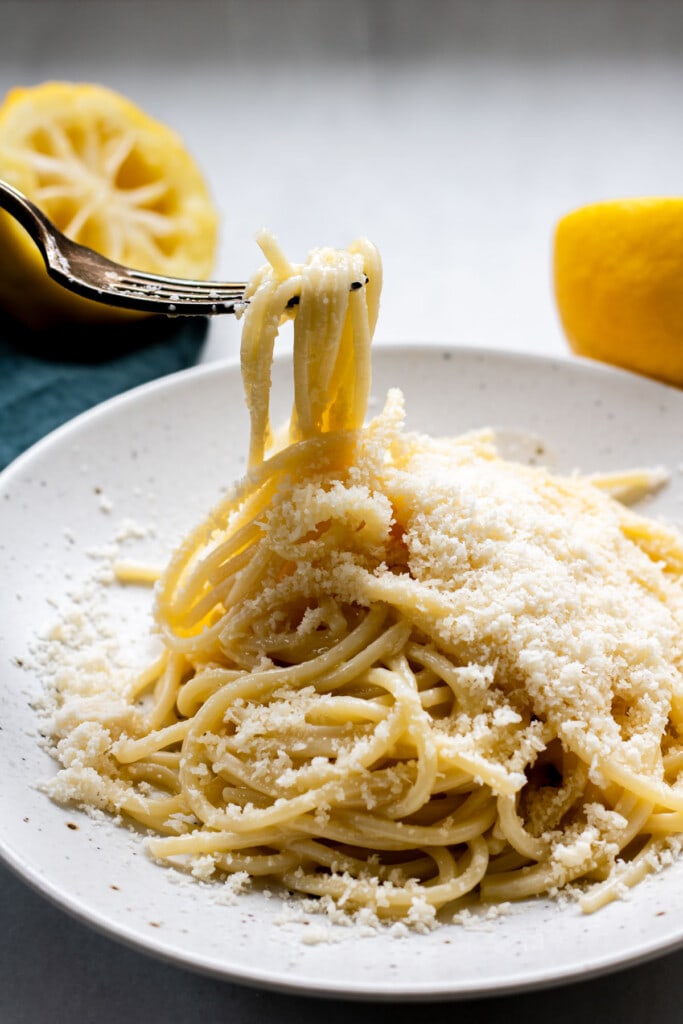
If you are looking for more delicious pasta recipes, try this Amazing Lobster Pasta with Creamy Tomato Sauce or my Creamy Vegan Lemon Pasta with Peas and Spinach.
Lemon Pasta, Pasta al Limone, Lemon butter pasta, whatever you know it as this is one of my all-time favorite pasta dishes. The magical combination of butter and fresh lemon emulsified in a creamy silky sauce is one of the best ways I can think to dress a strand of spaghetti. Light yet creamy, intense yet sophisticated, this creamy pasta al limone recipe is inspired by the tables of southern Italy and re-interpreted through the hands of a classic New York chef and is the number one requested pasta dish from both sides of my family.
This is the second installment of my ‘Cooking with Doppio' Series. In case you are unfamiliar, Doppio is the Italian nickname of my husband Jordan, who is prone to eating two meals per sitting when we are in Italy….double meals = doppio.
In Italy surrounded by the bounty of saucy, carb-centric options on offer, his already voracious appetite goes into overdrive and he does his best to try and taste as much as humanly possible. This version of pasta limone actually comes from a place much closer than Tuscany or Sorrento…it's from New York City. I'll let Jordan (Doppio tell you all about it).
You'll Love this Recipe
- This is one of the quickest recipes I know of and yet it delivers big time flavor power. This ratio of simplicity to flavor output has been a feature of many an Italian recipe.
- A creamy texture with fresh lemon flavor, buttery goodness and salty cheese…yes and please.
- An easy dinner main course that can be on the table to everyone's delight in just a little longer than it takes water to boil.
- Emulsification makes culinary magic – Emulsification is defined as: Physical Chemistry. the process of making two liquids into a colloidal suspension, in which particles of one liquid are dispersed throughout the other but not dissolved in it. In other words, butter and salty starchy water combine to make a luscious creamy sauce flavored by ripe lemons and rich cheese.
Doppio Notes:
I have cooked many versions of this delicious pasta dish but this is the one I make the most. The beauty is the simplicity of how it distills the best qualities of its ingredients into a sum greater than its parts.
I was first introduced to this method by Frank Prizinsano a genuine NYC chef who has been a restauranteur in the city since the days when it was a cash business. Frank has a handful of popular restaurants dotting the East Village serving the kind of comforting and delicious Italian fare that makes you feel like it's Sunday night at your nonna's table.
His restaurants, Supper and Frank were part of a weekly rotation I had with my restaurant industry buddies. Places we sought out for their straightforward, unpretentious cooking and relaxed atmosphere where we could unwind on a night off from our own restaurant jobs and experience being on the other side of the table. Some of my fondest memories belong to those nights and this lemon pasta recipe is a perfect example of something we ate sitting shoulder to shoulder laughing together, hoping that the night would never end. – Jordan
Let's Get Cooking!

Ingredients and Helpful Substitution Tips
Detailed measurements and ingredients can be found within the recipe card at the end of this post.
There are only 4 main ingredients in this delicious recipe so it's worth it to treat yourself to the highest quality ingredients you can find. Spring for premium pasta, organic lemon, and high-quality grass-fed butter. They all make a difference.
- Long pasta like spaghetti or chitarra – (stay away from vermicelli or angel hair- too thin and pappardelle- too thick). Buy the best quality pasta that budget allows. It's worth it for this dish. A few of Doppio's favorite Italian brands are: Monograno Felicetti, Mancini, and Rustichella D'Abruzzo
- Salted Grass Fed Butter – The salt enhances flavor and grass fed butter just tastes better.
- Organic Lemon – Because you will be adding the lemon peel to the sauce, you want to use organic lemons. No one wants to mix pesticides into their Pasta al Limone sauce.
- Parmigiano Reggiano – Only the best
Optional Add-Ins
This simple dish is perfect as-is, and this is the classic iterations, but if you want to play around a little bit with flavor here are a few options:
- Fresh parsley, basil, or chives
- Preserved lemon amps up the salinity and pucker level
- Anchovy, either melted into the pan with butter or just big fat anchovy slices on top
How to Make This Recipe
- Grate Parmigiano-Reggiano cheese on the side of a box grater with the fine holes. Alternatively, use a Microplane grater. Set aside
- Cook pasta, add enough kosher salt so that the water tastes like the ocean. Reserve a cup of the pasta cooking water.

- Prepare a second pot on the stove. Keep the pot warm by filling it with hot water while it waits for pasta to be ready.
- Prepare the lemon pasta by adding al dente pasta to your warmed pot, add 5 tablespoons of cold grass fed butter cut into pieces into the pasta.
- Squeeze lemon juice into the pasta and add squeezed lemon halves into the pasta. Add starchy pasta water and stir with a wooden spoon bashing the lemon halves to release lemon oil and stirring rapidly to emulsify the sauce. This emulsification is the secret to the sauce. It is how these simple ingredients get turned into something greater.

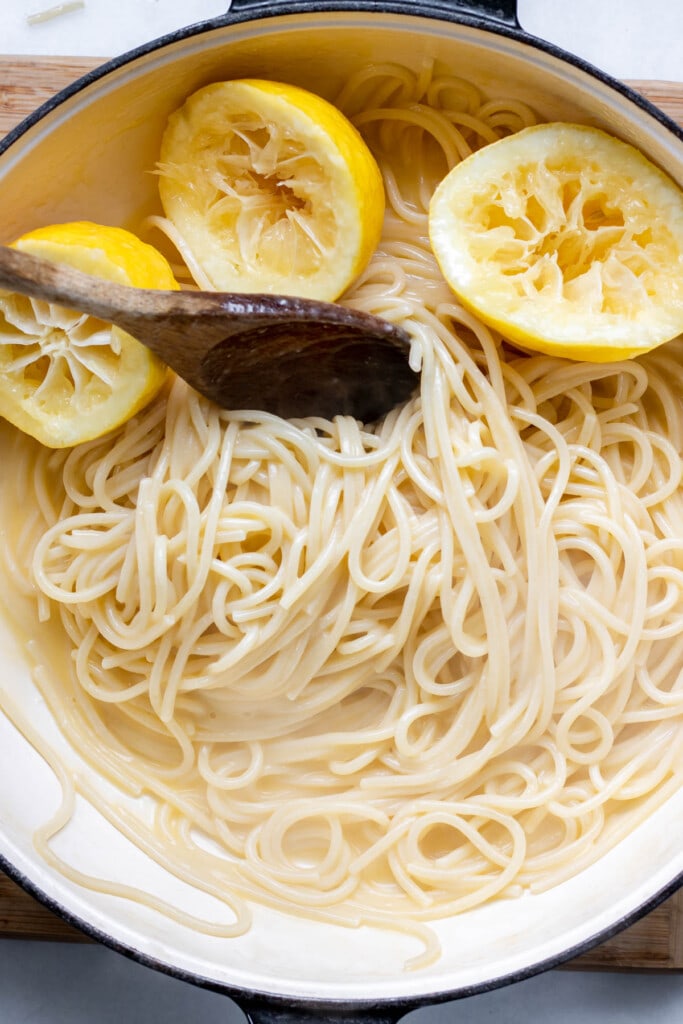
- Continue to add more pasta water if the sauce looks too dry or tight. At this stage, the sauce should be slightly loose, glossy, and creamy.
- Taste and add more lemon, butter, and pasta cooking liquid as needed and as preference dictates. The result should be a sauce that is neither very loose and runny nor pasty and gloopy; a light sauce intense with flavor.
- Serve the creamy pasta on individual plates and top with a generous heap of the grated parmigiano-reggiano cheese (about 1/4 cup per serving – A LOT OF CHEESE!)
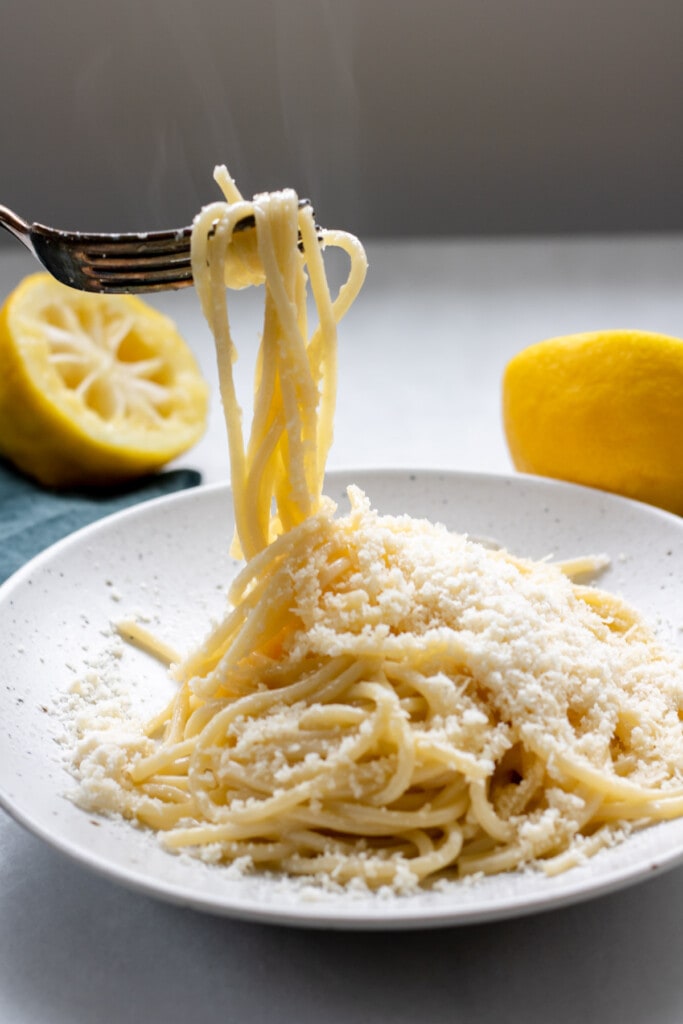
What to Serve with Pasta Al Limone
- Garlicky greens like broccoli rabe or spinach
- A crisp light green salad
- Italian olive oil shrimp salad
- Pork or Chicken cutlets
Expert Tips
- I do not recommend using lemon zest – resist the urge to add lemon zest to this dish. It might seem like it would enhance the flavor but the zest and rind can be too intense and sometimes too bitter. Since this sauce is just ingredients warmed through (rather than actually cooked) the rind does not have time to properly incorporate and become happy with the other ingredients.
- Warm the Mixing Pot – Be sure to warm the pot you are mixing your pasta and sauce in. A cold pot will reduce the temperature of the ingredients and halt them from incorporating and smoothly combining. The pot does not need to be blazing hot. I like to fill a pot with hot water and let it sit as I am preparing the dish. I then empty the water just before the pasta is finished cooking. That way my pot is warm and ready to receive the pasta and the rest of the ingredients.
- Taste and Adjust – This is a recipe, but as Frank Prisiano says it's really “A Method”. When a recipe contains so few ingredients there will be variability. Lemons are not all uniformly sour, so start with 3 tbsp of lemon juice, taste and adjust. I have made this with 3 whole lemons and only 1 lemon, I have made it with 4 tbsp of butter and 8 tbsp of butter. Taste and adjust.
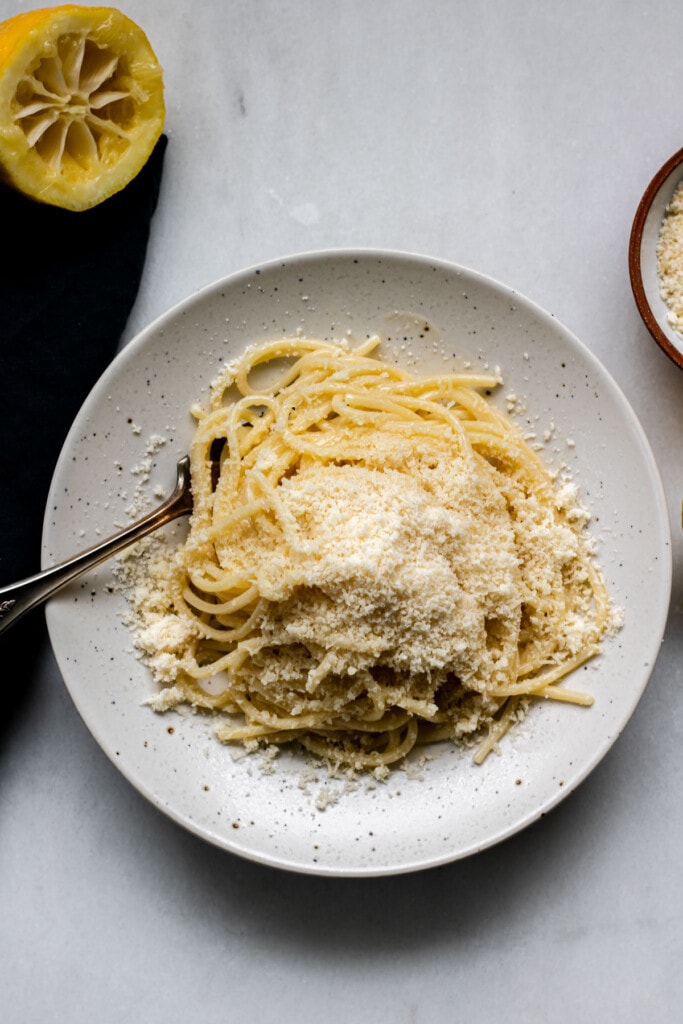
Make Ahead, Storage, Reheating, and Freezing Instructions
Well friends, this recipe is truly made best in moment and not the best candidate for leftovers. If you do have leftovers I recommend refrigerating for no more than one day and gently reheating in a pan on the stovetop or in the microwave, but you will need to add more liquid.
FAQ
No. It would be a mistake to think that fresh pasta is superior to dried pasta. Each type has its merits in different dishes. The type of sauce often dictates which pasta type and shape best to use. Some dried pastas create a superior surface for sauces to cling to and often spend their last minutes cooking on the sauce to absorb and intensity of flavor. Fresh pasta has a more delicate and silky texture, a desirable trait for ravioli and filled pasta. Dry pasta and fresh pasta are often interchangeable. The classic ragu bolognese can be found served with both types.
Sure. Meyer lemons have a sweeter flavor with a hint of orange. Regular lemons have a slightly more acidic profile for a very pleasing counterpoint to the richness of the butter, cheese and salt. Sorrento lemons from the Amalfi coast would would be purist's preference in this dish. They are also known for their sweeter profile but lack the orange undertones of the hybrid Meyer lemon. I've always had amazing results with a regular ripe organic lemon.
The origins are somewhat ambiguous but most research suggests that pasta al limone hails from southern Italy, the Sorrento peninsula and Amalfi coast. This region is famous for their lemons. The lemons used in this recipe are from Sorrento.
Dietary Modifications
This recipe is naturally vegetarian and easily modifiable in the following ways
- Gluten-Free – Ok, I tested this recipe 3x using different gluten free pasta and had GREAT success. This is easily modifiable using gluten free pasta, any kind you'd like.
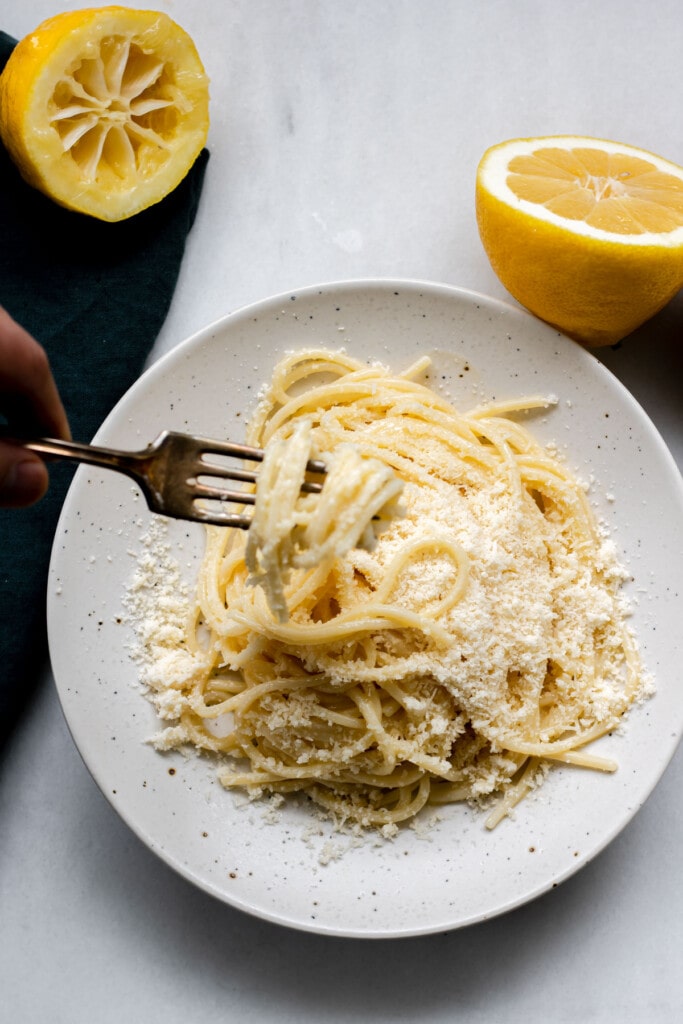
I can’t wait for you to try this! When you make it, snap a photo and tag me on Instagram @abrapappa or use the hashtag #abraskitchen so I can feature your photo!
If you’ve tried this recipe, don’t forget to rate it and leave a comment below. I love to hear from people who’ve made my recipes!

Pasta al Limone
Ingredients
- 1 lb dried spaghetti or chitarra
- 8 tbsp salted butter
- 2 organic lemons about 2-3 tbsp of FRESH lemon juice
- salted pasta water
- 1 cup freshly grated Parmigiano-Reggiano cheese
Instructions
- Bring a large pot of generously salted water to a boil. Add pasta and cook according to package instructions. RESERVE PASTA WATER once pasta has been cooked
- While water is boiling, fill a separate large pot with warm to hot tap water. Set aside. You will use this pot to stir all of the ingredients together
- Cut a cold stick of salted grass-fed butter into 8 equal pieces. Set to the side.
- On the small hole side of a box grater, grate 1 cup of Parmigiano Reggiano cheese. Set aside.
- A minute before the pasta has finished cooking, dump the water from the secondary warmed pot into the sink. The pot should now be nice and warm and ready to receive the ingredients.
- With tongs, remove noodles from the cooking pot and transfer them into the warmed reserved pot. It is okay if some pasta water makes its way into the mixing pot as well. (You will need pasta water to make the sauce) RESERVE AT LEAST 1 CUP OF SALTY STARCHY PASTA WATER.
- Add 5-6 pieces of the cold butter and stir.
- Place a mesh sieve above the pot of pasta. Hand squeeze 3 lemon halves over the sieve so their juices flow into the pot and the seeds are caught by the sieve. Start with about 3 tbsp of lemon juice, typically 1 lemon will contain 2 tbsp of juice depending on the size and juicienss of the lemon. Place the lemon halves (now without juice) into the pot with the rest of the ingredients. Mix thoroughly to emulsify the sauce, bashing the lemon with the back of a wooden spoon to release the lemon oils into the pasta.
- Taste for balance and preference. Add more lemon juice, butter, and pasta water to correct flavor and consistency. The goal is for a balanced lemony butter flavor with a glossy creamy sauce.
- Plate the pasta with a used lemon half as garnish. Top with a heap (about 1/4 cup of cheese per serving) of grated Parmigiano Reggiano cheese. The cheese will slightly thicken the sauce as it mixes in with the pasta. Buon Appetito!
Video
Notes
- Resist the urge to add lemon zest to this dish. It might seem like it would enhance the flavor but the zest and rind can be too intesne and sometimes too bitter. Since this sauce is really just ingredients warmed (rather than actually cooked) the rind does not have time to break down.
- Be sure to warm the pot you are mixing your pasta and sauce in. A cold pot will reduce the temperature of the ingredients and halt them from incorporating and smoothy combining. The pot does not need to be blazing hot. I like to fill a pot with hot water and let it sit as i am preparing the dish. I then empty the water just before the pasta is finished cooking. That way my pot is warm and ready to receive the pasta and the rest of the ingredients.


















